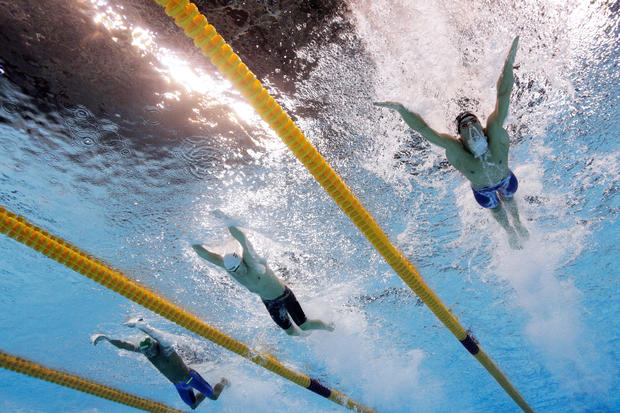Robotic cameras offer rare look at Olympians in Rio
Photographer Adam Pretty isn't scared to go to extreme depths to get his shot. At the Olympics, his cameras are, too.
The Getty Images photographer is capturing some of the most memorable moments of the Rio Games' swimming competition by using robotic cameras secured to the floor of the Olympic pool. His images provide an intimate view of swimmers as if watching the competitors while lying on our backs.
Among Pretty's pics: A photograph of US swimmer Michael Phelps elongating seconds after torpedoing in the water for his signature event, the 200-meter butterfly. The most-decorated athlete in Olympics history added to his haul on Tuesday, winning the race by four one-hundredths of a second. The closest margin of victory in history.
Pretty also shot American Katie Ledecky moments before winning the 400-meter freestyle final, a new world record and the first of three gold medals at the Games.
These shots and hundreds of others like them wouldn't have been possible without Pretty's use of robotic cameras that are controlled remotely. Getty photographers have used robotic cameras for years, typically to take shots from overhead. The Rio Games, however, mark the first time the agency has used them to get images from the bottom of the pool at the Olympics. (Reuters photographers used similar technology at the London Games in 2012.)
"It's revolutionary from our point of view," Pretty said during a phone call from Rio before he prepared to shoot Friday's events. "With these cameras we can cover the whole event as you would above water, only it's under water."
The cameras are attached to the floor of the pool using suction cups and operated from poolside using a remote control that resembles an Xbox video game controller. Pretty relies on a laptop computer -- as well as his instincts -- to snap swimmers coming into frame in split-second fashion.
The cameras have great flexibility. Using the remote control, Pretty can spin, zoom, tilt and pan the cameras. Pretty says that allows him to get tight shots and close-ups in ways we could have never imagined.
"When I first got my hands on it, it was like getting a new toy," Pretty said, adding he didn't know what to do with it at first. Now, he said, "this is pushing me to test my limits."
Pretty, from Sydney, is covering his fifth Summer Olympics and has two decades of professional experience. He says the technology has given him the license to make changes during races in real-time in a way he couldn't before because the camera swivels and pivots. This allows him to reduce the margin of error.
"Rather than plan for one shot, I can get the whole race," he said. "We have a very small window, but if I want to get Phelps doing his dive in the water, I can position the camera and then say, 'Bang,' I got that shot!'"
With two swimming sessions lasting several hours each day, Pretty said there's immense pressure and spirited competition with his rivals to get eye-catching images. As many as 10 photo agencies vie for underwater shots. Each agency is allowed one camera in the pool at a time.
Pretty is working with fellow Getty photographers Al Bello and Clive Roseto provide coverage at the Olympic swimming events. They split shifts on the robots, which are equipped with a Canon 1DX Mark II camera that can shoot 14 frames per second.
The photographers, all of whom are scuba trained, also don underwater gear to check on the technology daily. Their routine includes monitoring power cables that stretch 200 feet across the length of the pool, Pretty added.
"The robots doesn't do it all for you," he said. "It's a tool to use, along with your experience, to take the best shots possible."
This story originally appeared on CNET.

